Chemical and Thermal Analysis
Scientist in charge
Dr. Maria del Puerto Morales Herrero (Research Professor)
Dr. Sabino Veintemillas Verdaguer
Technicians
María del Carmen García González (OPIS Technical Specialist)
Carolina Chaparro Ronda (OPIS Research Assistants Scale)
Anselmo del Prado (Research Assistant)
Manuel Galera Luque (Senior FP Technician)
Contact
+34 913349000 ext 437107, 437021, 437132
Location
Chemical Analysis --> Lab 107
Thermal analysis --> Lab 021
Chemical Analysis Service
The Chemical Analysis Service allows the determination of major, minor and trace elements in samples from any scientific-technological area.
To guarantee reliable measurements and that the equipment is in optimal conditions, periodic calibrations and verifications are carried out and a safety criterion is chosen that consists of rejecting any verification whose tolerance is less than or equal to 10%.
Measurements
- ICP-OES: The ICP technique allows the quantitative and qualitative determination of metals, metalloids and some non-metallic elements, in a wide variety of samples, from a solution.
- Elemental Analysis: Elemental analysis CHNS, also known as organic elemental analysis or elemental microanalysis, allows to measure the quantity of C, H, N and S in a sample. It is a technique widely used in the quality control of different compounds (organic, inorganic, organometallic compounds, polymers, catalysts...). It is very useful for determining the purity and homogeneity of a compound and calculating its empirical formula
Equipment:
- Inductively Coupled Plasma (ICP) Atomic Emission Spectrometer PERKIN ELMER mod. AVIO 220 MAX
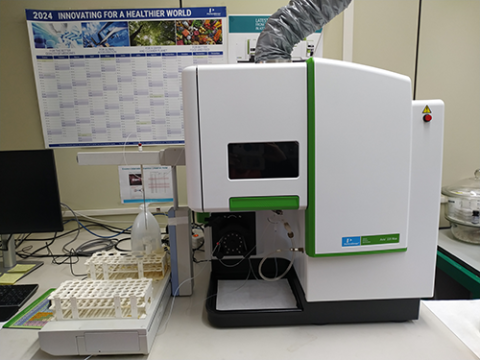
It has dual automatic observation of the plasma (Axial and Radial) The measurement in axial mode allows reaching the lowest detection limits (ppb depending on the element and type of sample) while with the radial mode the range of measurement concentrations is much more high. The equipment covers a wide spectral range between UV and Visible (160-900nm). It has a double monochromator optical system, with a wide response throughout the spectral range, but especially high in the UV zone.
Measurements are made at two wavelengths to detect possible spectral interference
- TruSpec Micro Elemental Determinator CHN/CHNS LECO
TruSpec Micro CHNS equipment burns the sample in a high temperature furnace, which cause the sample to combust. This combustion converts carbon in CO2, hydrogen in H2O, nitrogen in N2 and sulfur in SO2. These gases are swept with helium and detected by independent IR cells, this allows a simultaneous measurement of C, H and S. N is measured using a thermal conductivity detection system.
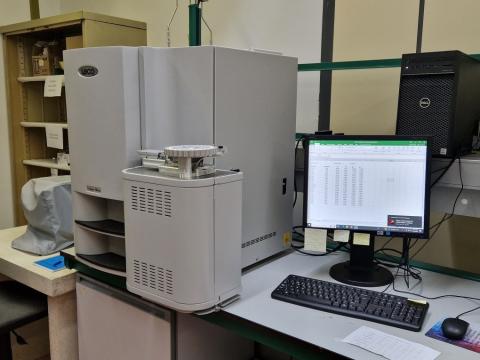
Allowed samples
- ICP-OES: ICP-OES allows the determination of major, minor and traces elements in samples from any scientific-technological area
The minimum sample volume must be 10ml (maximum two elements). For measurements of more than two elements consult the laboratory.
The samples must be well dissolved, without suspended particles or precipitates.
The pH of the samples must be slightly acidic, using a maximum of 30% concentrated HCl or 30% concentrated HNO3
Samples are not allowed on HF. - Elemental analysis: All types of samples such as composites, algae, nanoparticles, polymers, graphene or biomaterials, among others, are analyzed.
Samples must be properly packaged and labeled. In each sample, the identification code must appear clearly, visibly and indelibly written, and must coincide with the code designated in the analysis request.
Depending on the composition and toxicity of the samples, the service reserves the right to decline the analysis.
Thermal analysis service
Our thermal analysis service offers a full set of complementary techniques that allow the deep understanding of the thermal behavior of different materials following the changes produced in some property as a function of temperature. These analyses can be performed in heating, cooling or in isothermal modes, and all of them in controlled atmosphere conditions.
Measurements
- Thermogravimetry (TGA) continuously measures the mass of a sample in a controlled atmosphere, as a function of temperature or time as the temperature of the sample increases linearly over time.
- Differential Thermal Analysis (DTA) measures the temperature difference between a substance and a reference material by applying a temperature ramp in a controlled atmosphere.
- Differential Scanning Calorimeters (DSC) measure temperatures and heat flows associated with thermal transitions in a material. This technique tracks the amount of energy required to increase the temperature of a material by a certain amount. Differential Scanning Calorimetry can detect changes in material properties at exact temperatures, revealing important transition ranges and deterioration points.
- TGA-Mass Spectroscopy, this technique allows the simultaneous analysis of the gases released during the TGA analysis. This technique facilitates the comprehension of the chemical processes undergone by the sample during the TGA analysis. Sensitive method for the analysis or gaseous reaction products.
General applications:
- Analysis of the thermal stability of materials.
- Study of the decomposition and oxidation of materials.
- Determination of moisture and volatile content.
- Material purity analysis.
- Detection of glass transition temperature, melting, crystallization, curing and curing kinetics.
- Determination of enthalpies of melting and crystallization.
- Calculation of heat capacities
- Adsorption/Desorption in catalysts
- Heat driven inorganic processes in solid state (reaction elucidation, changes of stoichiometry)
- Studies of pharmaceutical products (stability, residual solvent, formulation effects)
Equipment:
- Two TA Instruments Q600 thermobalances (TG/ATD/DSC). High sensitivity microbalance for studies of thermogravimetric (TG), Differential Thermal Analysis (DTA) and Differential Scanning Calorimetry (DSC) of solid materials in general. Experimental temperature range: 25°C-1000°C. Heating rates between 1°C/min and 100°C/min. The studies can be carried out both in an inert atmosphere and in a flow of chemically active gases at variable flows.
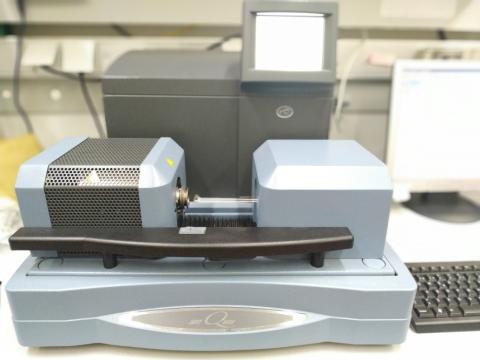
Pfeiffer quadrupole mass Model Thermostar/omniStar for gas analysis (m/q ratios 1-300 amu), equipped with double detector (Faraday and Channeltron) to achieve high sensitivity during TG-MAS Spectroscopy analysis.
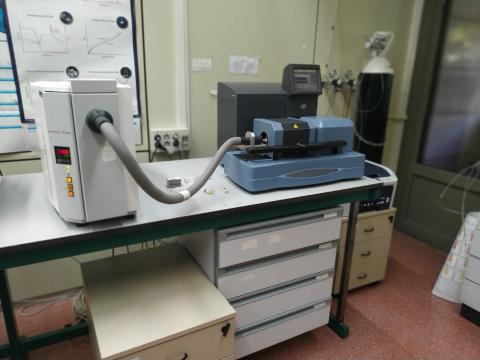
The Differential Scanning Calorimeter (DSC-MDSC) Q2000 TA Instruments analyzes between -150ºC to 500ºC mainly solid samples in non-reactive atmospheres. Conventional DSC measure heat flow related to the phase transition of materials as a function of time and temperature.
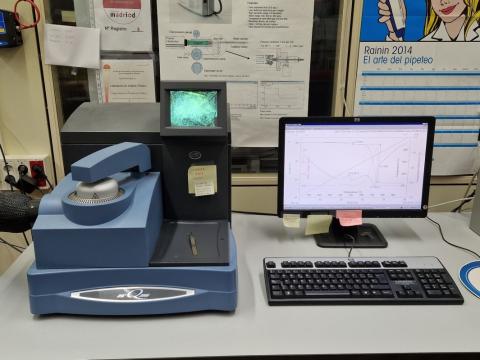
Allowed samples
The recommended minimum amount of solid sample is needed 10mg, but this could vary depending on the nature of the sample.
Samples must be properly packaged and labeled. In each sample, the identification code must appear clearly, visibly and indelibly written, and must coincide with the code designated in the analysis request.
Depending on the composition and toxicity of the samples, the service reserves the right to decline the analysis.
Instituto de Ciencia de Materiales de Madrid (ICMM)
Sor Juana Ines de la Cruz, 3
Cantoblanco, 28049
Madrid, España
Telephone: (+34) 91 334 90 00
Email: @email
Communication Office: @email

Acknowledge the Severo Ochoa Centres of Excellence program through Grant CEX2024-001445-S/ financiado por MICIU/AEI / 10.13039/501100011033

Contacto | Accesibilidad | Aviso legal | Política de Cookies | Protección de datos


